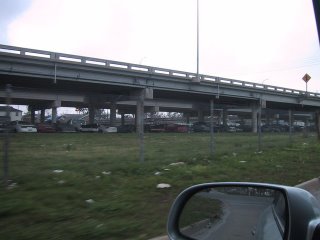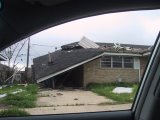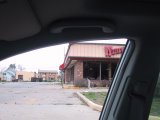I fly from Phoenix to New Orleans, landing around noon local time. I decided to rent a car for the week, so that I could drive around (given the opportunity) and take in some of the area sights. I have been to New Orleans a number of times in the late 80s and early 90s, and have a bunch of great memories of the area.
While at the airport, I think back to the news in the days following hurricane Katrina, with pictures of the hundreds of people who were staying and/or being triaged on the airport grounds. All of those people have now gone, and it seems apparent that there are far fewer flights & travelers within the airport as well. It is the week after Mardi Gras 2006, and I barely see any hints of it.


As soon as I leave the rental-car parking lot, I can immediately see evidence of katrinas destruction. There are businesses along the airport road which are still damaged (many still closed). While driving to the freeway, I see something that seems strange, but will become a very common site for me throughout the trip - massive broken-down cars piled in one place beneath the raised freeway roads. It looks like a scrap-yard with no fences to protect the cars.


I opt for the shorter (non-freeway) route to St. Bernard Parish, and drive through somewhat eerie, deserted streets. There are many destroyed cars in the roads, in yards, and even see a truck atop a large tree. Every home and business that I see after leaving the freeway is empty, and most have very apparent damage. I am surprised at the number of abandoned & damaged vehicles that I see on every street, and under a number of freeway ramps. It is very eerie driving through these areas, even though it is the middle of the afternoon. One image that really captures my eyes, is that of two very mature trees which have been toppled...
After a 20 minute drive, I arrive at Camp Premiere (a federally-run Tent City) housing a number of contractors, volunteer groups, and, as I later find, a number of local families who have no other place to go.
St. Bernard Parish was complely devastated by Katrina: 100% of the commercial, and nearly 100% of the residential structures received damage. Of the 69,000 residents and 25,000 households, there were 128 casualties and only 3 houses were spared damage. Only 11 houses were habitable after the hurricane. Because St. Bernard Parish is 1/2 feet above sea level, flood insurance had not been required.
I had originally signed up thinking that it would be rewarding to go and get dirty, while helping out people in need. After injuring my finger (a flag-football injury from a month earlier), I did everything I could to be able to put on the required protective leather gloves (I even had my Dr. build a smaller splint), but it was not to be. Even with the small splint, and scouring every Home Depot, Lowes, Walmart, and Ace Hardware store near where I live, I could not find a suitable work glove that would go over my finger. UGH! (btw - it just happens to be my right middle finger, causing many to laugh when I show them my splint) ;-)
Upon arrival, I am directed to the parking facility by security (U.S. Federal contract Police), and asked to visit the registration tent to sign-in, and receive my credentials. While registering I inform them that I have a fractured finger and need to find suitable duties. They direct me to a "special operations" sign-up sheet, and I am told that someone would be contacting me.


I am assigned to Tent 11A (Not sure how many tents in total there are, but most are 15-person tents, filled with cots, lights, a few electrical outlets, and climate control. Having climate control is critical, as it is very hot & muggy during the days, but very cold at night... although, it turns out that not everyone's 'comfortable temperature' is the same, and in a tent with 14 other people, it seems to be up to whomever sleeps closest to the thermostat wins.
After dragging my very heavy duffle bag to 11A, I notice that there are no free cots, and all seem to already be fairly close together. i walk back to registration, and they suggest that I simply grab a cot from 3A (a currently unoccupied tent), and 'make it fit' in 11A. Not quite the accommodations that I often experience, but I'm here to help, not to be comfortable! :)
I spend the next few hours touring the facility, and sitting through a 1.5 hr orientation (teaching people about N-95 Respirators, mold, what to do when you find: live snakes and rats, dead domestic pets, weapons & ammunition, and many dangerous chemicals (many of each of these items were found during the week that I was there)).
Anxious to find out what I will be doing, I head over to the Habitat tent, and am directed to Tom Pfalzer, who is responsible for Special-Ops. Tom asks me many questions about what areas I have experience in, after hearing that I have enjoyed working on vehicles since I was young, he gets VERY excited, and says that I will be responsible for vehicle maintenance and repair of the Parish (county) vehicles which are used to pull trailers full of tools to the neighborhoods where the teams are working. He asks me to show up at 7AM to meet the Tools teams, and to get a handle on how things operate. Off to bed now.
















































